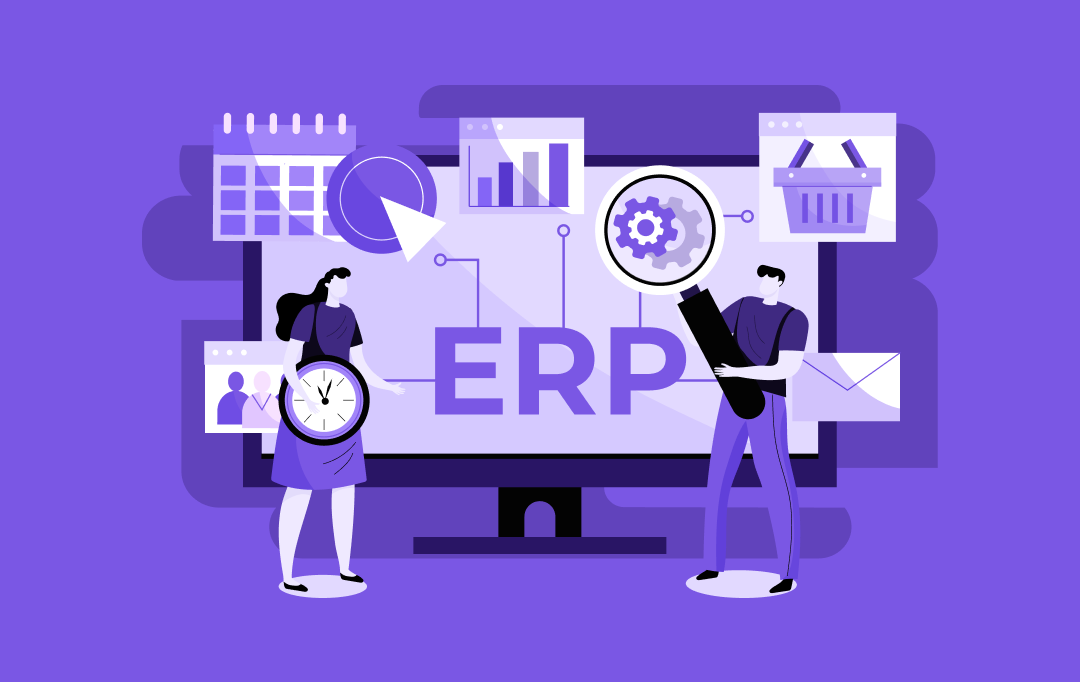- Off-The-Shelf Software vs. Custom Software Development
- What are the Benefits of Custom Software Development?
- Personalized User Experience
- Robust Security
- Scalability and Flexibility
- Increased Productivity
- High-End Integration
- Cost-Effectiveness
- Reliability
- Exclusive Ownership
- Types of Custom Software Development
- Video Streaming Software
- Customer Relationship Management (CRM)
- Enterprise Resource Planning (ERP)
- Content Management Systems (CMS)
- Fintech Software
- Operations Management Software
- Healthcare Software
- eCommerce Software
- Custom Software Development - Step-by-Step Process
- Ideation and Planning
- Designing and Prototyping
- Development
- Testing and Quality Assurance
- Deployment
- Upgrade and Maintenance
- What is the Cost of Custom Software Development?
- Factors That Affect the Custom Software Development Cost
- Software Complexity
- Software Design
- Development Methodologies
- Geographical Location
- Software Platform
- How Can Appinventiv Help in Your Custom Software Development Journey?
- FAQs
The ever-evolving customer needs and technological advancements are prompting businesses to upgrade their system to keep pace with the trends. With the constant change in the digital paradigm, companies are actively looking for ways to transform their operations. While off-the-shelf solutions have undeniably revolutionized industries, they often fall short in addressing the intricacies of every business. It is where a new frontier, custom software development emerges to effectively address the market needs on many different fronts.
Custom software development is a game-changing process that empowers businesses to craft tailored solutions aligned with their unique needs. Unlike one-size-fits-all solutions that come with limitations and hinder the true potential of business growth, custom software opens a gateway to limitless possibilities. It allows companies to redefine their digital infrastructure to drive efficiency and gain competitive advantages.
As per the report of Grand View Research, the global market size for custom software development is estimated to reach $146.18 billion by 2030, driven by a projected compound annual growth rate (CAGR) of 22.5%.

Custom software development is the process of planning, designing, developing, and deploying digital solutions for a specific set of functions, users, and organizations. For instance, a banking app is specifically designed to meet the unique needs of a bank and its customers, and a healthcare app is built to cater to the needs of patients and medical professionals.
However, irrespective of industries or business domains, custom software development helps streamline operations, enhance customer experience, and gain a competitive edge. Also, it helps apprehend the customer’s pain points and enables businesses to predict future demands.
Considering the manifold advantages of custom software application development, here is a comprehensive discussion on why custom solutions have been a dire necessity of the modern business world.
Off-The-Shelf Software vs. Custom Software Development
The software that comes pre-packaged with features is called Commercial Off-The-Shelf software (COTS). The vendor that develops it is responsible for updating its versions, and enterprises use it by paying a licensing fee. It is designed to meet the universal needs of the mass market. Zoom, an online meeting and video conferencing software, is an example of COTS that gaind widespread attention during the global lockdown age.
On the other hand, the software designed and developed by a custom software application development company as per your unique needs is called custom or bespoke software. Made on order, it weighs highly on features relevant to your requirements.
Tasks that standard software will take ages to complete can be accomplished quickly with custom software development solutions. Think of it this way; COTS is a public utility vehicle that considers travelers’ combined choices and drives fast enough to appease those onboard, while custom software is that private car you can instruct as per wish and break the speed limits.
Here is a chart to help you understand the differences between off-the-shelf and custom solutions.
| Custom Software | Off-The-Shelf Software |
|---|---|
| Best for meeting specific user needs. | Good for a broad range of users. |
| Costly but scalable and flexible, which can be easily tailored to suit your goals. | Cost-effective, but you can’t modify it as per your needs. |
| It only includes necessary and user-centric functions. | Feature-rich, but most of them are invaluable for users. |
| The company has exclusive ownership to modify and maintain the software. | The company depends on software providers for maintenance and upgrades. |
In today’s ever-evolving digital landscape, custom solutions can make all the difference, as off-the-shelf software can’t always meet the market’s changing needs. It is why businesses across industries are progressively turning to Custom software development in USA, and Worldwide to gain a competitive edge.
What are the Benefits of Custom Software Development?
Custom software development benefits businesses in various ways, helping them streamline processes, boost productivity, enhance customer experience, and meet business objectives. Here are some significant benefits of custom software development businesses can enjoy by choosing custom solutions over off-the-shift software.

Personalized User Experience
Nowadays, every user wants personalized interactions with a brand, and custom software development is designed to offer a personalized user experience. Unlike COTS software, which caters to the need of a broad audience, custom solutions are tailored to address unique challenges and meet specific business requirements. The custom solutions are built with specific features and technologies of your choice, helping organizations gain a leading position in their respective domains.

Robust Security
Unlike off-the-shelf software, custom application software provides robust security to users. It is a closed-source project and only used by your team, minimizing the risk of intrusions. On the other hand, people with ill intentions can easily execute their malicious attempts to hack COTS software as it typically uses open-source code, and hackers are aware of such vulnerabilities.
Scalability and Flexibility
Custom software provides flexibility to organizations to scale it up or down as per the business needs. Unlike off-the-shelf applications, custom software can be tailored to specific requirements without violating licensing agreements and facing potential consequences.
Increased Productivity
Custom software development aims at streamlining and automating business processes, which helps businesses boost productivity and gain competitive advantages. By reducing the need for manual labor and the risk of human errors, custom solutions help improve operational efficiency, enhance customer experiences, and deliver innovative products or services.
Additionally, It allows businesses to saves custom order management system development
High-End Integration
Investment in COTS software becomes a catch-22 situation where you discover you have to program extensions into the system to make it worthwhile. Investing the same efforts in a custom software application that integrates effortlessly with the system saves you cost, time, and energy.
Cost-Effectiveness
With custom software, you can plan the development process conveniently. You need not contribute an enormous amount of money at once to receive the rewards of automation. Based on your business plan and funds accessibility, you can begin automating the single process and schedule other automation stages to make custom software development affordable.
Reliability
Software reliability is crucial for all organizations, and counting on custom software application development is a secure and reliable approach to streamlining operations. Custom software developers use cutting-edge technologies and industry-leading protocols to secure the applications, ensuring the top-notch performance and reliability of the software.
Exclusive Ownership
With custom software development, you own all the rights to modify and maintain the product without any restrictions to suit the ever-changing need of the market. So, if you encounter any issues with your existing software, you can connect with your development team to get efficient technical support to address and resolve the issues at the earliest possibility.
Also Read- How much does it cost to build a church management software like ChurchTrac and PushPay
Types of Custom Software Development
There are countless types of custom software solutions catering to the diverse needs of businesses across industries. Let’s delve into some most common types of custom software development that companies can consider to streamline their operations and bring value to customers.

Video Streaming Software
In today’s rapidly evolving digital landscape, streaming platforms are one of the most used custom software, popular among all genres of users, allowing them to watch content even without an internet connection after downloading the content.
One great example of such a custom platform is Netflix which provides users exclusive access to watch movies and series. Another example is YouTube which allows users to watch videos and publish content.
Customer Relationship Management (CRM)
It is one of the most popular types of software businesses use to reinforce their relations with customers. Salesforce can be one of the best examples of CRM software.
Enterprise Resource Planning (ERP)
This custom enterprise software development type helps manage the business workflow in real-time. Typically, organizations use ERP solutions to collect, manage, store, and interpret data from different business verticals.
Content Management Systems (CMS)
Content management software like WordPress helps organizations design, update and edit the various types of content on their websites.

Fintech Software
Fintech software is highly valuable for financial institutions and their customers to manage their banking activities, digital wallets, crowdfunding, cryptocurrency investments and so on. With secure fintech solutions, financial firms can significantly enhance user experience and protect their customers against potential frauds or data theft.
[You may like reading: Exploring Fintech Application Development Costs in 2025]
Operations Management Software
Companies can utilize such software to automate their crucial business processes and optimize operations. Such digital solutions can be tailored to comply with definite project goals.
Healthcare Software
Healthcare software is bliss for medical professionals and patients alike. It helps manage patients’ records, schedule appointments, design personalized treatment plans, schedule doctor visits, and do much more.
Also Read: 15 types of healthcare software to take your medical business to the next level.
eCommerce Software
It is probably the most popular type of custom product software development, enabling businesses to expand their online presence and generate higher ROI. Such software is specifically tailored to streamline online sales, manage inventories, expand markets, create brand awareness, engage customers, carry out effective marketing campaigns and so on.
One of the best examples of eCommerce software is Amazon Android and iOS apps. The global tech company focuses on multifaceted eCommerce services, advertisement, cloud computing, and AI, enabling users to enjoy a safe and convenient shopping experience.
You may like reading: IT infrastructure software development – The why’s and how’s
Custom Software Development – Step-by-Step Process
Custom software product development is a highly complex and challenging process that requires the technical expertise of a top custom software development company in New York like Appinventiv. Here is a step-by-step custom software development process.

Ideation and Planning
The first and foremost step in custom web software development starts with understanding the business requirements, risks, and objectives. Therefore, a custom software development consultant collaborates with the client to collect information, identify market trends, define business requirements, and weave a comprehensive plan for the development process.
Designing and Prototyping
Once the custom software development consulting firm collects the needed information and identifies the requirements, the next step is to design an intuitive user interface and create prototypes. This stage of the development process involves developing a visual presentation of the software, enabling stakeholders to give their feedback and make changes accordingly before developing the final product.
Development
It is one of the most important stages, which involves writing codes and programming the software based on the approved prototypes. The developers leverage the best-in-class methodologies and cutting-edge technologies to ensure that the software meets the highest security and performance standards.
Testing and Quality Assurance
It is time to perform rigorous testing to ensure the software is secure, user-friendly, and bug-free. To ensure top-notch quality and performance of the software, the tech experts conduct various tests, like performance testing, functional testing, security testing, etc. If the software experts find any errors or glitches during the testing, they fix them immediately before launching the product to market.
Deployment
Once the software succeeds in passing all the testing phases, it is now ready to be launched for the end users. An efficient custom application software development company integrates the final product either into the company’s infrastructure or submits it to the app store for a successful launch.
Upgrade and Maintenance
After the software is developed and deployed, it requires regular maintenance and upgrades to stay effective and deliver up-to-date performance. This stage involves implementing updates, fixing bugs, and offering constant support as needed.
Custom business software development is an ongoing process. While some companies prefer to do it with their in-house development team, Appinventiv has found that outsourcing custom mobile software development can significantly reduce cost, improve flexibility, optimize efficiency, increase speed, and drive innovation. Outsourcing custom software development, enabling enterprises to improve software performance while focusing on their core business tasks.
Deloitte’s global outsourcing survey revealed that 70% of organizations turned to outsourcing with one priority: reducing costs.
Outsourcing the best custom software development for startups and enterprises provides endless benefits to businesses while giving valuable guidance throughout the development process. It is why offshore custom software development firm are gaining immense popularity with each passing day.
What is the Cost of Custom Software Development?
Custom software development cost is something that catches everyone’s attention who is interested in building their own digital products. However, it is difficult to give a precise estimate as the cost to develop custom software varies significantly depending on various factors. On average, custom software development cost ranges between $30,000 to $200,000 or more, depending on your industry and business needs.
Every custom project is distinct, as businesses belong to different domains and have unique requirements and objectives. Thus, the features and functionalities of custom solutions vary, leading to bringing significant differences in the cost of custom software development. For instance, the software built for healthcare organizations will have entirely different features and purposes than one designed for the finance sector.
Factors That Affect the Custom Software Development Cost
Estimating the accurate cost of custom software development seems challenging due to the various factors involved in the software’s success. Here is a detailed list of factors affecting the overall cost of developing a custom solution.

Software Complexity
Software complexity is one of the most critical factors that impact your custom software development cost. The complexity of the software depicts how much effort the developers require to develop the software. Big projects with multiple features typically cost more than smaller ones with limited ones. The more complex your software is, the higher it will cost.
Also read: How Much Does it Cost to Maintain a Software? All You Need to Know
Software Design
Another significant factor contributing to software cost is its UI/UX design, architectural design, and basic design. The interface of your product must be user-friendly and engaging, which can deliver a seamless user experience. The more intricate and nuanced your interface is, the more it will entice the end users, resulting in increased development costs.
Development Methodologies
There are different methodologies and approaches to developing software, including agile, spiral, waterfall, hybrid, or iterative. These development methodologies for better app usability indicate your software’s robustness and scalability. Each of the methodologies has its pros and cons; they all work differently and have different costs.
Geographical Location
The cost of custom software development varies significantly depending on the geographical location of your offshore custom software development company.
To optimize the development budget effectively, one strategy is to outsource tasks to Asian regions like India. In these areas, highly skilled development teams provide solutions of top-notch quality at an optimized cost. Utilizing the expertise, resources, and technologies available in Asian countries can significantly boost project efficiency while making way to manage costs efficiently.
Moreover, with the rising trend of global talent acquisition, development teams in Asian countries are adept at meeting both international and local compliance standards. Collaborating with a development team in such locations can effectively tackle complex development challenges while ensuring cost-effectiveness.
Here are estimated hourly development rates across different regions that affect the costs of custom software development.
| Region | Hourly Rates of Development |
|---|---|
| UAE | $60 to $65 |
| US | $95 to $100 |
| Western Europe | $80 to $90 |
| Australia | $70 to $90 |
| Eastern Europe | $50 to $55 |
| Asia | $25 to $40 |
Software Platform
The platform you want your custom solution to run on also contributes to development costs. Typically, there are three main types of platform-based software development – iOS, Android,, or multiple platforms. The choice of platform should be made based on the market trends and your user preferences.
How Can Appinventiv Help in Your Custom Software Development Journey?

Appinventiv has a proven track record of achievements in both standard and on-demand software solutions. With extensive experience in delivering exceptional custom software development services, we specialize in emerging technologies and addressing complex business challenges.
With a team of 1600+ technology nerds, we have successfully completed more than 3000+ software projects. We work closely with each of our clients and emphasize understanding their business processes, goals, and constraints. It empowers us to create state-of-the-art custom solutions that meet customers’ expectations and their unique go-to-market milestones.
We have worked with numerous reputed companies from various sectors, such as Adidas in eCommerce, Soniphi in healthcare, Nova in education, MAAN in agriculture, and Domino’s, Pizza Hut, and KFC in the food industry.
We recently collaborated with Asian Bank to design, develop, and launch a comprehensive Fintech software that allows consumers with crypto assets to store, transact, and convert their assets into fiat currency. It’s a core banking system with all the necessary features and capabilities.
For another client JobGet, we build innovative software where job seekers and employers can message each other and schedule meetings in real-time. The platform has helped to bring down the job search process from months to days for blue-collar workers. Being the no.1 recruitment app for blue-collar workers, JobGet has successfully placed more than 150,000 jobseekers to date, and the company has bagged $52 million in funding for their innovative product idea.
In case you are also looking for custom software development services, contact us for a journey full of innovation and achievements. Our experts will guide you throughout the process and help you develop software that customers will love and embrace.
FAQs
Q. What is custom software development?
A. Custom software development refers to the process of designing, developing, deploying, and maintaining software applications that are tailored to meet specific user needs and business challenges while providing them competitive advantages.
Q. How much does custom software development cost?
A. Typically, the cost of custom software development ranges between $40,000 to $300,000 or more, depending on several factors such as project scope, complexity, and required features.
Q. How long does the development of custom software typically take?
A. The timeline for developing custom software varies based on project complexity, scope, and requirements. On average, it can take anywhere from a few months to over a year to complete the development process.
Q. What are some common challenges encountered during custom software development?
A. Organizations often face several challenges during custom software development, including changing requirements, technical complexities, resource constraints, and communication issues. Changing requirements, driven by evolving business needs or user feedback, can disrupt project timelines and budgets. Technical complexities, such as integrating with existing systems or adopting new technologies, may require innovative solutions. Resource constraints, including budget limitations or talent shortages, can further hinder development efforts. Effective project management, proactive planning, and open communication among stakeholders are essential to overcoming these challenges and ensuring successful software delivery.


- In just 2 mins you will get a response
- Your idea is 100% protected by our Non Disclosure Agreement.

Custom Development or White Label Solutions: Which is Right for Your Business?
Key takeaways: 77% of companies are prioritizing digital transformation; the right tech approach is crucial for staying competitive. Custom development offers tailored solutions for unique needs, flexibility, and long-term scalability. Whereas, white-label solutions provide quick market entry, cost-efficiency, and easy customization for standard needs. Appinventiv’s expertise helps you navigate custom development vs white-label to choose…

ERP Integration in Australia - Why It Is Essential and How to Do It Right
Key takeaways: ERP integration enables operational efficiency, reduced costs, and enhanced decision-making. Healthcare, finance, manufacturing, retail, and all the other sectors are benefiting from ERP integrations in Australia. While ERP integration can be costly, ranging from AUD 45,000 - AUD 450,000, it leads to significant long-term savings and scalability. Compliance with Australian regulations is critical,…

Predictive Analytics Software Development - Features, Benefits, Use Cases, Process, and Cost
Key Takeaways Predictive analytics helps businesses shift from “what has happened” to "what will happen," enabling proactive strategies rather than reactive ones. Real-time analytics and AI integration are driving the growth of predictive analytics, making it more accurate, accessible, and critical for business success. Custom predictive analytics solutions can enhance customer satisfaction, reduce costs, and…


















